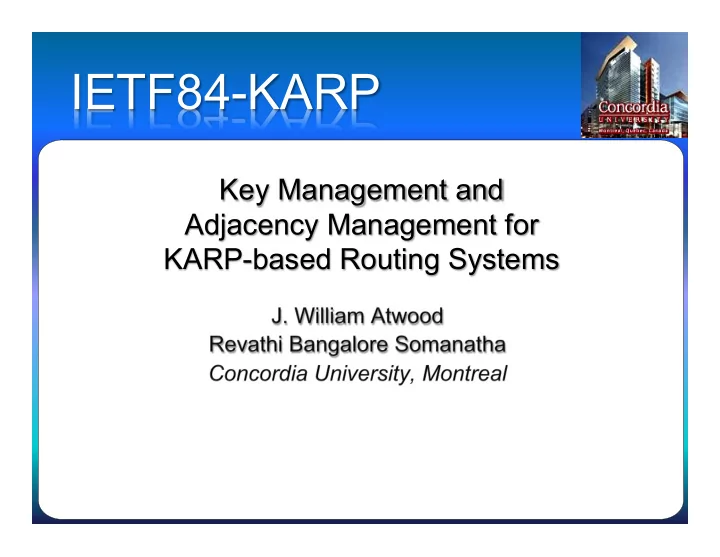

IETF84-KARP Key Management and Adjacency Management for KARP-based Routing Systems
Definitions Administrative Domain (AD) Set of routers under a single administration • RFC 4375 provides a convenient definition (in the context of Emergency Management) An AD is not bigger than an autonomous system • Because we are dealing with Interior Gateway Protocols Group Controller/Key Server (GCKS) Specific to a particular routing protocol (RP), because “adjacency” may be defined differently for each RP • Rules may be the same for different protocols, but stored data will be different 2012-07-31 IETF 84-KARP 2
Definitions..2 Group Member (GM) Any router within the Administrative Domain • Note that depending on the keying model in use, we may form smaller “groups” Neighbor The set of routers that are adjacent to a particular router 2012-07-31 IETF 84-KARP 3
AS and AD 2012-07-31 IETF 84-KARP 4
Keying ¡Scopes ¡(1) ¡ Whole ¡AD ¡ Same ¡key ¡for ¡the ¡en;re ¡AD ¡ ¡ 2012-07-31 IETF 84-KARP 5
Keying ¡Scopes ¡(2) ¡ All ¡routers ¡on ¡a ¡link ¡ Key ¡per ¡link ¡ ¡ 2012-07-31 IETF 84-KARP 6
Keying ¡Scopes ¡(3) ¡ Group ¡per ¡sending ¡router ¡ Separate ¡key ¡per ¡router ¡ ¡ 2012-07-31 IETF 84-KARP 7
Keying ¡Groups ¡(4) ¡ Group ¡per ¡sending ¡router ¡per ¡interface ¡ Separate ¡key ¡per ¡router ¡per ¡interface ¡ ¡ 2012-07-31 IETF 84-KARP 8
Keying ¡Groups ¡(4) ¡ Group ¡per ¡sending ¡router ¡per ¡interface ¡ Separate ¡key ¡per ¡router ¡per ¡interface ¡ ¡ 2012-07-31 IETF 84-KARP 9
Keying Assumptions for RKMP and MaRK Both documents make the same statement “Routers need to be provisioned with some credentials for a one-to-one authentication protocol” “Preshared keys or asymmetric keys and an authorization list are expected to be common deployments” 2012-07-31 IETF 84-KARP 10
Observations (1) To establish the router identities and legitimate adjacencies, this will involve walking to each router and carefully configuring the paired keys and authorization lists Or, at the very least, remotely logging on to each router... This seems somewhat error prone to us 2012-07-31 IETF 84-KARP 11
Observations (2) Adjacency control has to be centralized No individual router can determine, by itself, who its legitimate neighbors are We have explored the issue of key generation in the context of making adjacency management easier. The operation of MaRK appears to us to make managing adjacency more difficult Specifically, the election of a GCKS for the routers on a link, which can be different each time it happens. 2012-07-31 IETF 84-KARP 12
Our goals To explore ways that allow easy adjacency control (which has to be centralized) Without depending on a central facility when you have a power failure In a manner that works for both the unicast and the multicast cases 2012-07-31 IETF 84-KARP 13
Key Management Architecture Overall Controller Protocol GCKS Protocol Keystore Group Group Member Member Local Local KS/GCKS KS/GCKS Local Local Keystore Keystore 2012-07-31 IETF 84-KARP 14
Structure Two levels for the Automatic Keying Management GCKS GM Negotiation GM GM Negotiation Four steps Mutual authentication (GCKS each GM) Push policy and adjacency information on this path Mutual authentication (GM to each adjacent GM) Push or negotiate keying material from GM to/with adjacent GMs 2012-07-31 IETF 84-KARP 15
System Goals To generate, distribute and update keying materials 11 “security goals” 6 “non-security goals” These were assembled from review of the Design Guide and the Threats and Requirements Guide Details are in the draft 2012-07-31 IETF 84-KARP 16
Results The framework allows us to simplify the establishment of the pre-shared keys Allows us to introduce centralized control of adjacency Allows incremental deployment, with different keying models on different interfaces Avoids DoS attacks on the central controller after power failure 2012-07-31 IETF 84-KARP 17
System architecture Conforms to the Multicast Group Security Architecture Specification 2012-07-31 IETF 84-KARP 18
Key Management Phases: Between Components Overall Controller Step 1 Step 1 Protocol Step 2 Step 2 GCKS Protocol Keystore Step 3 Group Group Member Member Local Step 4 Local KS/GCKS KS/GCKS Local Local Keystore Keystore 2012-07-31 IETF 84-KARP 19
System Operation (1) Step 1 – Mutual authentication GCKS to GM Establish secure path and mutual authenticity between GCKS and individual Group Members • This path will be used to distribute information for use by the GM to identify and authenticate its neighbors Standard IKE or IKEv2 exchange 2012-07-31 IETF 84-KARP 20
System Operation (2) Step 2 – Push policies to the GM SA policy corresponding to the TEK Signed certificate to identify this router Key scope to be used Policy token Adjacency information Plus the necessary hashes and nonces to ensure that the security requirements are met 2012-07-31 IETF 84-KARP 21
System Operation (3) Step 3 – Mutual Authentication between adjacent GMs Establish secure path and mutual authenticity between adjacent Group Members • To be used to distribute parameters that will be used by the GM to send information to its neighbors (i.e., routing protocol control packets) The identity information pushed in Step 2 is used to identify legitimate neighbors Standard IKE or IKEv2 exchange 2012-07-31 IETF 84-KARP 22
System Operation (4) Step 4 – Exchange or negotiation of keying materials SA information corresponding to the TEK of the sending router Request for SA information corresponding to the TEK of neighbor routers Plus the necessary hashes and nonces to ensure that the security requirements are met 2012-07-31 IETF 84-KARP 23
Key Management Exchanges: Within GMs KMP (Key Management SA parameters related to TEK Protocol) LKS (Local Key Server) Join group Notification Initial key of new keys Change key Key Store RP SA parameters (Routing Protocol) related to TEK 2012-07-31 IETF 84-KARP 24
Academic Aspects Formal validation of the security of the protocols has been done, using AVISPA (Automated Validation of Internet Security Protocols and Applications) GCKS and GMs are modeled Intruder can take any role Security goals (for example, secrecy of the generated TEK) can be formulated AVISPA reports “safe” for the set of security goals and scenarios explored 2012-07-31 IETF 84-KARP 25
Thank You! Questions? 2012-07-31 IETF 84-KARP 26
Recommend
More recommend